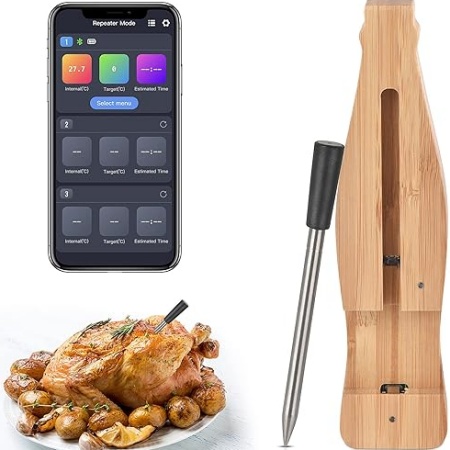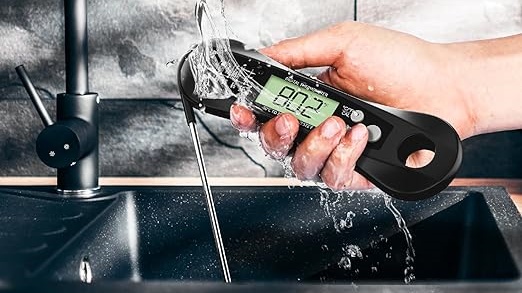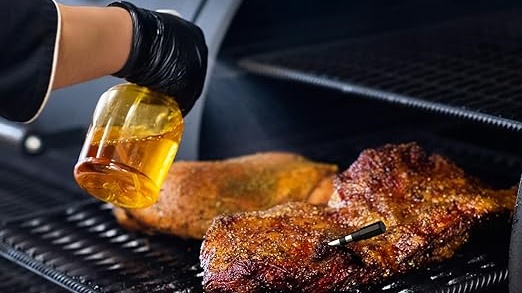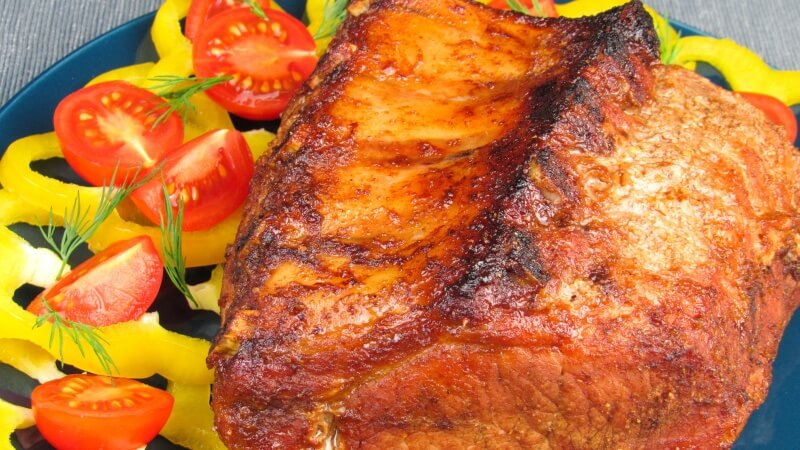
How To Enhance Your DIY Meat Probe with Voice Control Features
Every culinary enthusiast knows the importance of a perfectly cooked steak, and that’s where a meat probe comes in handy. But what if we could

When it comes to ensuring your culinary creations are cooked to perfection, a meat probe is an indispensable tool.
But, just like any kitchen gadget, it requires regular cleaning to maintain its accuracy and hygiene. In this blog, we’ll walk you through the simple yet effective steps to keep your meat probe in tip-top shape.
Every chef, amateur or professional, knows that a meat probe is crucial for cooking meat precisely. But before we dive into the cleaning process, let’s get to know the different types of meat probes and their structures.
There are various types of meat probes, such as digital and dial types, each with its own specific features. Digital probes offer quick and precise readings, while dial probes provide a classic, analog approach to temperature taking.

Regardless of the type, each meat probe typically consists of a long metal rod connected to a display or dial. Digital probes often have features like instant read, backlight, or even Bluetooth connectivity, which adds complexity to their structure.
Dial probes, on the other hand, have a simpler, more robust design but may require calibration over time to maintain accuracy. Understanding the specific type of your meat probe is crucial for effective cleaning and maintenance.
Understanding the structure and materials of your meat probe is crucial for effective cleaning.
Most probes have a stainless steel rod, which is resistant to rust and easy to clean, and a handle that contains sensitive electronic components. It’s essential to know the parts of your probe to prevent water damage, especially to the electronic areas.
The handle may contain a battery compartment, digital display, or control buttons in digital probes.
These parts are particularly susceptible to water damage and should be handled carefully during cleaning. The probe’s rod is usually detachable in higher-end models, which can make cleaning easier and more thorough.
Before you start scrubbing away, preparation is key. Gathering the right tools and understanding the safety measures will make the cleaning process smoother and more effective.
To clean your meat probe, you’ll need mild dish soap, warm water, a soft cloth or sponge, and possibly a soft-bristled brush for tough residue. It’s important to avoid abrasive materials that could scratch the probe’s surface. Also, consider using a disinfectant or alcohol swab for sanitizing after you’ve cleaned the probe.
This is particularly important if the probe has been used with raw meat, as it can prevent cross-contamination. Gather your materials in a well-lit, clean area with enough space to work comfortably, ensuring all parts of the probe can be reached easily during cleaning.
Safety comes first when cleaning a meat probe. Make sure the probe is turned off and cooled down before cleaning.
Also, remember that hygiene is paramount, as the probe comes into contact with raw meat, making thorough cleaning essential to prevent cross-contamination.
Avoid immersing the entire probe, especially digital ones, in water, as this can damage the electronic components. Always use gloves if you prefer, and wash your hands thoroughly before and after cleaning the probe. Ensure that the cleaning area is free of food items to avoid any accidental contamination.
Now, let’s get down to business. Following these steps will ensure your meat probe is not only clean but also in good working condition.
Start by gently cleaning the probe rod with warm soapy water. Be thorough but gentle, ensuring you remove all food residue and grease. It’s crucial to avoid getting water into any electronic parts of the probe, as this can cause damage.
Use a soft cloth or sponge to wipe down the rod, paying special attention to any grooves or crevices where food particles might accumulate.
For tougher residues, a soft-bristled brush can be used, but be gentle to avoid scratching the rod. Rinse the rod under running water to remove soap residue, and dry it immediately with a clean towel to prevent water spots and rust.
The tip of the meat probe requires special attention, as it’s the part that penetrates the meat. Use a soft cloth or sponge to gently wipe the tip, being careful not to bend or damage it.
This part is essential for accurate readings, so treat it with care. If there are any burnt-on residues, you can soak just the tip in warm soapy water for a few minutes to help loosen the debris.
Avoid using abrasive materials or harsh chemicals that could damage the tip. After cleaning, rinse the tip thoroughly and dry it completely. If your probe has a protective cover for the tip, ensure that it’s clean as well and dry before placing it back on the probe.

After cleaning, proper maintenance is essential to prolong the life of your meat probe. Here’s how to store and care for it until its next use.
Once your meat probe is clean and dry, store it in a dry place. If it came with a storage case or cap, use it to protect the tip from damage. Keeping the probe in a drawer with sharp utensils can cause scratches or other damage.
Avoid coiling the cable tightly if your probe has one, as this can cause wear and tear over time. Instead, loosely coil the cable and secure it with a tie or clip. If your probe came with a holder or stand, use it to keep the probe upright and protected.
To prevent rust and keep your meat probe in the best condition, make sure it’s completely dry before storing.
If your probe is battery-operated, remove the batteries if you’re not planning to use it for an extended period. This prevents corrosion and prolongs the life of your probe. Periodically check the probe for any signs of wear or damage, such as cracks in the handle or fraying cables.
If your probe is showing signs of rust, you can use a mild rust remover, but be sure to thoroughly clean and dry the probe afterward. Regular maintenance checks will help you catch any potential issues early and keep your meat probe functioning accurately for longer.
Maintaining a meat probe isn’t just about cleaning after use. Here are some extra tips to keep your probe functioning accurately and for longer.
For stubborn residue, soaking the tip of the probe in warm soapy water for a few minutes can help loosen it. If necessary, use a soft-bristled brush gently to remove any remaining particles. Avoid using steel wool or other abrasive materials, as they can scratch the surface of the probe.
For burnt-on food, a paste made from baking soda and water can be gently applied and then rinsed off. This mild abrasive can help remove tough residue without damaging the probe.
Ideally, clean your meat probe after every use to ensure it’s always ready for your next cooking adventure. Regular cleaning prevents build-up of residue and maintains the probe’s accuracy and hygiene.
If you use your meat probe frequently, consider doing a deep clean once a month to keep it in optimal condition.
This includes checking the battery compartment for any signs of corrosion and ensuring all parts are functioning correctly.
Regular cleaning and maintenance not only keep your meat probe hygienic but also ensure that it provides accurate readings, which is essential for safe and successful cooking.

Keeping your meat probe clean is not just about hygiene for use it; it’s about ensuring the accuracy and reliability of this essential cooking tool.
A well-maintained meat probe is a chef’s best friend in the kitchen, guaranteeing that your culinary efforts yield delicious, perfectly cooked results every time. Remember, a clean meat probe is a happy meat probe!


Every culinary enthusiast knows the importance of a perfectly cooked steak, and that’s where a meat probe comes in handy. But what if we could

When it comes to cooking perfection, a meat probe is an indispensable tool for any chef or home cook. But in the world of meat

The moment you bring a meat probe into your kitchen, it’s not just about cooking anymore; it’s about precision, about transforming an ordinary meal into

Ever questioned if a meat probe could be your secret weapon for the perfect roast chicken? It’s a culinary showdown: the precision of a meat

Every culinary enthusiast knows the importance of a perfectly cooked steak, and that’s where a meat probe comes in handy. But what if we could

When it comes to cooking perfection, a meat probe is an indispensable tool for any chef or home cook. But in the world of meat

The moment you bring a meat probe into your kitchen, it’s not just about cooking anymore; it’s about precision, about transforming an ordinary meal into

Ever questioned if a meat probe could be your secret weapon for the perfect roast chicken? It’s a culinary showdown: the precision of a meat
Copyright © 2024 meaterprobe. All Rights Reserved.